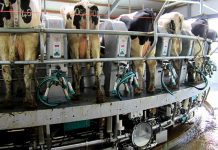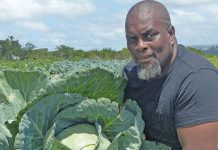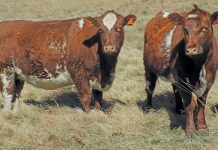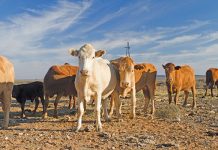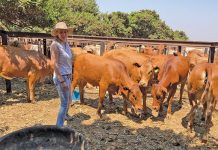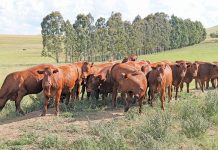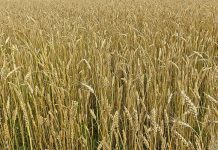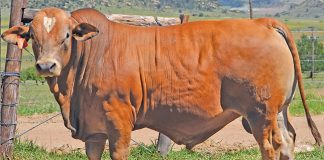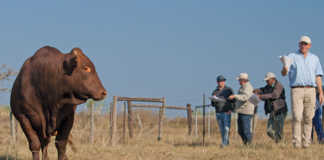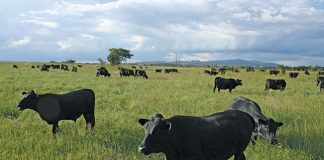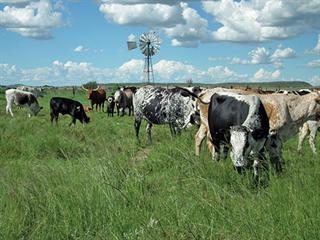
“I record the performance of every animal in my herd,” says Michiel van Niekerk, who farms 6 500 ha near Perdeberg in the western Free State between Petrusburg and Kimberley. Michiel is one of a few Nguni breeders who use estimated breeding values (EBVs) as selection criteria. Most Nguni breeders rely on visual appraisal and traits such as age at first calving and intercalving period (ICP). Although he values these traits, Michiel determines growth and maternal traits in his Nguni herd as well.
“This is the only way I can work out my profitability,” he says. Michiel farms extensively on veld in a semi-arid area and says his cattle must be suited to the particular environment. He bases his breeding programme on sound objectives. “This includes breeding fertile females with good milk production and strong maternal behaviour,” he says. Michiel believes that an efficient cow herd is the foundation of every successful beef enterprise.
“I select for fertile, functionally efficient and well-adapted females with above-average milk production coupled with growth to wean heavy calves on the veld for maximum profit with minimum input.” The Ganna Stud uses SA Studbook’s animal production recording system to determine EBVs. Cows and calves are weighed at weaning, and bull calves selected as potential stud bulls are put through a Phase D test on veld with only a phosphate and salt lick. The selected bulls are scanned by SA Studbook for eye muscle area, marbling, rib and rump fat.

Michiel van Niekerk. Photo by Annelie Coleman
Measuring
Michiel is probably the first Nguni stud breeder in South Africa to combine scanning for these carcass traits with a Phase D test. “The old adage ‘To measure is to know’ remains as true as ever,” he says. “I analyse and evaluate the herd data at least once a year, usually after the annual Nguni BLUP analysis.” He weighs and analyses each cow and calf at weaning to get the breeding values, as this helps him assess the profitability of the herd.
Replacement heifers calve when they are about two. The rest are culled, as are cows that do not conceive. In early June, a vet pregnancy-tests cows and heifers that have been mated. Michiel records age at first calving, ICP, cow weight at weaning and calf weaning weight at 205 days. Birth weight is not recorded, as calving problems in the herd are very rare. He focuses on the genetic ability of the calf to grow to weaning and calf growth derived from the dam’s milk production. These are traits that determine cow productivity and profit per hectare.
Read: Breeding indigenous Ngunis in the Piketberg
“The latest analysis was in September,” he explains. “Analysis starts with grouping. Ranking from the highest to lowest the best cows that have had three calves and more into 23 groups; there are four milk EBV groups, four weaning weight EBV groups, four mature weight EBV groups and four cow weight at weaning EBV groups. The last group consists of cows that have had at least four calves. There are also four cow efficiency EVB groups and three cow efficiency index groups. Cow profit EVB is a new selection index.”
Large-framed bulls such as Charolais and Simmentaler can be mated to Nguni cows with no resultant calving problems. According to the Agricultural Research Council, Nguni cows have the ability to inhibit foetal growth. The sloping rump of the Nguni also plays a crucial role in ensuring calving ease.
The Ganna Nguni environment
The land consists of sweetveld and shrub land dotted with clumps of camel thorn trees on sandy loam to clay soils.
The average annual rainfall is 404mm, with striking variations between seasons. The rainfall during the 2012/2013 season was only 120mm. The temperature can rise to more than 40°C in summer and fall to below zero in winter. Camps average about 120ha and each camp has a borehole-fed watering point.
The stud herd consists of 230 breeding cows, 110 heifers and 70 bulls in three different year groups: currently a 2011 group, a 2012 group and a group of older bulls. Michiel stocks at a rate of 18ha/MLU which is slightly lower than the official carrying capacity of 15ha/ MLU on shrub veld and 8ha/ MLU on the grassland. “When measuring and evaluating our carrying capacity, I consider only grass production. The shrub component is considered a bonus,” he explains.

The dry climate simplifies the herd health programme. Michiel inoculates for mandatory blackquarter, anthrax, botulism and BVD vaccines annually.
“The lower stocking rate has been a Godsend during this drought. I had far less rain than normal and it fell in sporadic showers. There seems to have been a change in the rainfall pattern over the past six or seven years; we no longer get widespread, general rain. The past winter has been relatively warm with very little frost.” Michiel divides his cow herd into single sire mating sub-herds of about 35 females to one bull.
“We put the bulls in on 1 December and take them out in September. This doesn’t mean I don’t have a fixed calving season, as cows that are still open are culled from the cow herd in early June. This makes bull management more practical,” he says.
According to Michiel, each sub-herd’s grazing needs are calculated against the official carrying capacity, and each is allocated a set of camps to cater for its grass intake for a year. This also applies to the young bull and heifer herds. Cattle are visually evaluated throughout the year.
The dry climate simplifies the herd health programme. Inoculations are required against black quarter, anthrax, botulism and bovine viral diarrhoea once a year, and heifers are vaccinated for brucellosis. “Heartwater traditionally did not occur in this area, but lately it has been reported as close as Petrusburg. Fortunately, Ngunis are resistant to heartwater, redwater and gallsickness. I never have to treat the herd against ecto-parasites because of the breed’s natural resistance,” says Michiel.
Predation is not a problem either, despite the healthy jackal population on the farm, he says. Ngunis are horned and efficiently fend off predators.
The small-framed Nguni cow weans a relatively heavy calf at a high weaning ratio. She is fertile, presents virtually no calving problems and gets along with minimum labour, veterinary care, parasite control and lick.“Our animals performed well on the veld without any supplementary feed despite this year’s terrible drought. We supply a salt and phosphate lick throughout the year, but in high rainfall years also a protein lick, although only at 50% of the amount recommended for small- to medium- framed cattle breeds.”
For Michiel, it makes economic sense to farm Ngunis. “The results of a study at the Mara Research Station in Limpopo confirm this. The Nguni came out on top in this study comparing the meat production potential of small-, medium- and large-framed cattle. Nguni cows produced the most kilograms of calf weaned per 100kg cow mated. They had the highest calving rate and lowest calf mortality rate. A study at the Omatjenne Research Station in Namibia gave the same results.”
Linking stud to commercial
A stud breeder must keep the commercial cattleman’s profit margin foremost in mind in his own breeding objectives, says Michiel. “He should know more about what makes a commercial farmer’s operation profitable than the commercial operator does. We provide breeding stock, especially bulls, with the appropriate genetic merit to increase the profitability of their herds.”
Read: The Nguni of sheep
According to Michiel, this starts by producing bulls that sire daughters that first calve at about two years and every year after that, increasing the frequency of genes for more efficient cows in the herd. “Cows must have the growth and maternal traits needed to raise excellent calves with the lowest input possible, the basis of a profitable beef enterprise. Maximum adaptability is not negotiable. Select for the function and the correct form will follow,” he concludes.
Phone Michiel van Niekerk 083 234 0358 or email [email protected].

